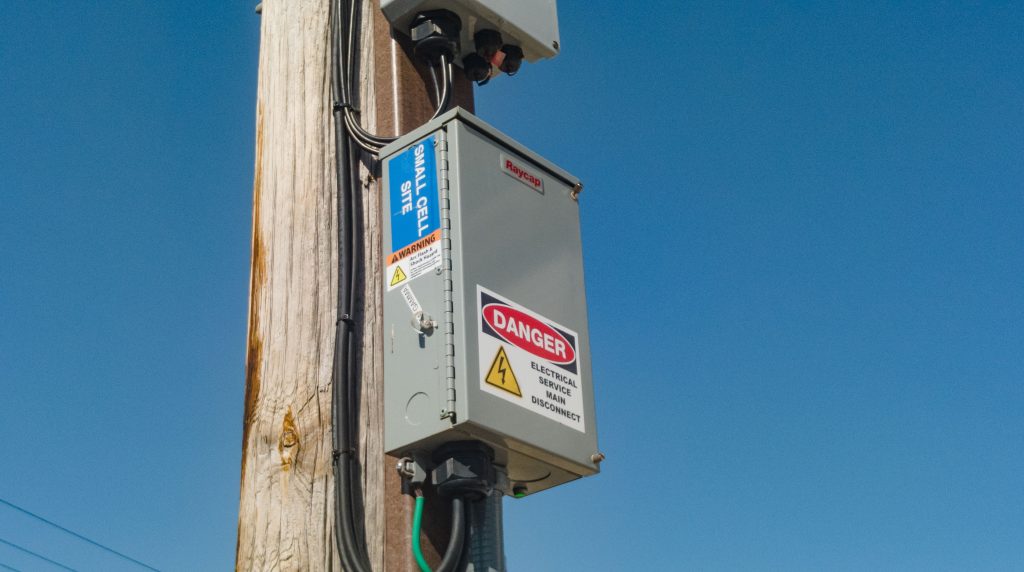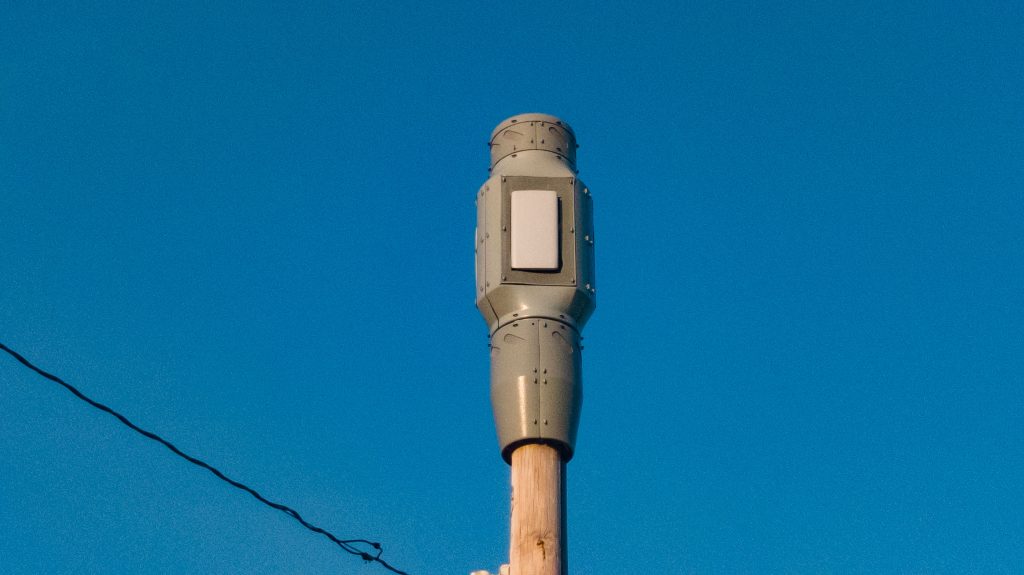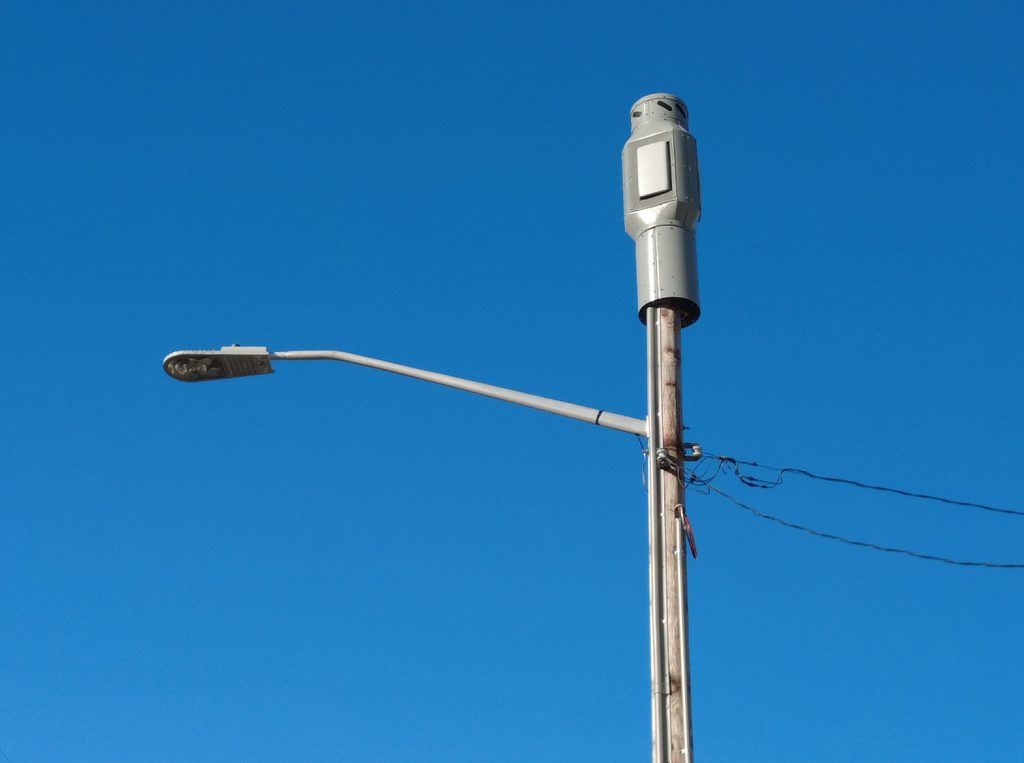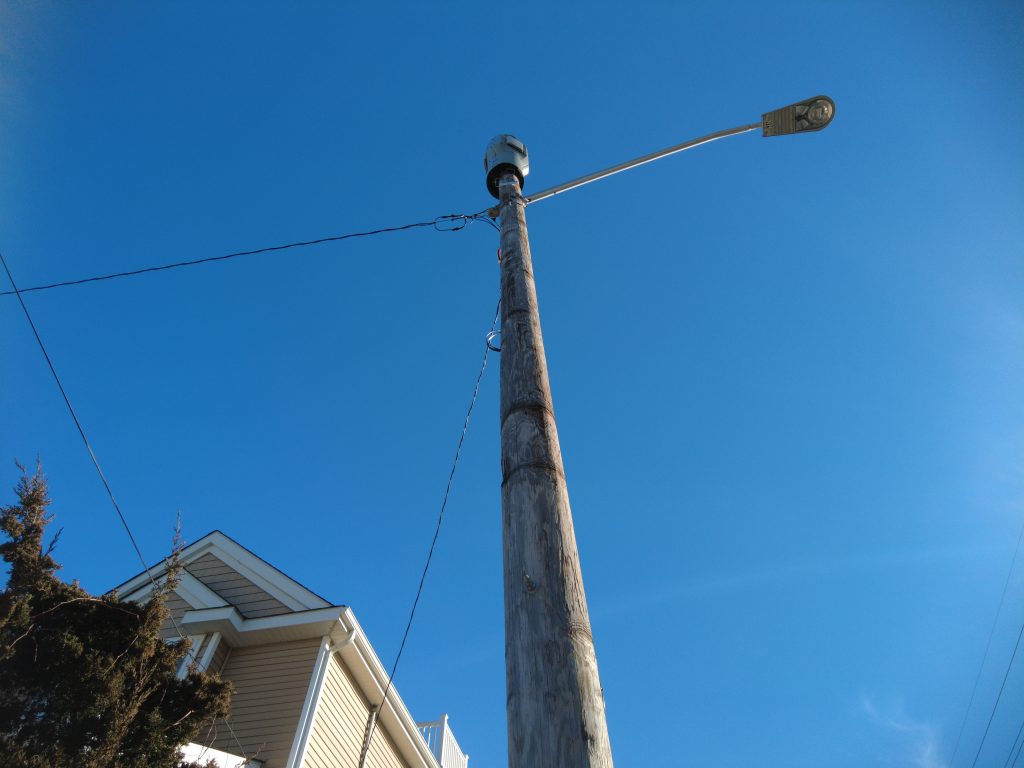
A small 5G wireless facility on top of an existing timber pole, Lavallette, N.J., May 2023. (Photo: Shorebeat)
Lavallette’s back-and-forth battle with Verizon over an increasing number of “small cell” nodes around the borough will continue after the planning board adjourned a hearing over six newly-proposed nodes pending the submission of more information from the wireless provider.
Verizon’s representatives were pitching new nodes – the “caps” seen on top of some utility poles in town that provide additional bandwidth for high-speed wireless applications – at six locations, though board members agreed one address provided was misleading and too close to a park.
The nodes are proposed for:
- 72 Oceanfront
- 102 President Ave.
- 2201 Baltimore Ave.
- 100 Oceanfront
- 110 White Ave.
- 506 Oceanfront
“I think it’s about time Verizon takes into account the human side of this nonsense,” said board member Joanne Filippone, who also serves on the borough council.
Filippone’s comments set the tone for much of the meeting, with members pressing Verizon officials on why the company was the only wireless provider coming back, again and again, for permits to install network nodes across town. A radiofrequency engineer hired by Verizon testified that as an original descendant of the Bell System, the current day Verizon utilizes different frequencies in the broadcast spectrum to carry its signals. Other companies that began as startups and gradually merged together have access to all of the original spectrum of their ancestors, plus have bid on additional spectrum that has been made available. In other words, different carriers operate on different frequencies, and some require small cell nodes at the street level, while others operate more efficiently from very tall monopole towers covering a wide area.
Edward W. Purcell, an attorney representing Verizon, said his client’s application for wireless node permits was compliant with the borough’s ordinance regulating 5G and small cell network nodes. The federal government gives municipal governments only small regulatory power over the deployment of such networks, as they are seen as part of the national communications infrastructure. Municipalities are allowed to set simple regulations covering aesthetics, proximity buffers and, in some cases, height. The planning board, in this particular case, does not have the power to grant Verizon a permit, but is tasked with making a recommendation to the borough council, which will vote to agree with the board’s decision or not.
“Every antenna is proposed as brown and all of the cabinets are proposed as gray,” Purcell said, addressing the look of the nodes. “All of the equipment on all of the new poles has the same height and the same camouflaging.”
Purcell also said Verizon would not object to co-location – multiple wireless providers sharing a tower or utility pole – if space allowed.
“We would allow co-location on the pole if the town would allow a higher pole to be installed,” he told the board.

A small 5G wireless facility on top of an existing timber pole, Lavallette, N.J., May 2023. (Photo: Shorebeat)
The proposed small cell nodes will carry both 5G and 4G signals. The “caps” on top of utility poles carry 4G signals while boxes beside them power 5G high-speed signals, capable of delivering 1 gigabit (download) and 100 megabit (upload) connections, fit for streaming, teleconferencing, and data-intensive uses.
Board members took issue with one the location of one proposed node at 2201 Baltimore Avenue, an address that does not exist. Instead, the pole would be placed in front of a home on Elizabeth Avenue, adjacent to the baseball field across the street.
“Nobody from Elizabeth Avenue knows this is going in front of their house, and that is wrong,” said Filippone, who was also critical of the appearance of the nodes installed so far.
“They’re going higher and higher, uglier and uglier, and now you want to paint them brown when the poles are really a driftwood color,” she said. “Other companies are providing 5G services in Lavalllettee without any of this ugly stuff. Why come into my community and make it ugly?”
Filippone’s comment prompted the lengthy explanation on radiofrequency spectrum and its history.
Ultimately, the board did not reach a decision on whether to recommend the six towers be approved. The board’s planner and engineer, as well as board members themselves, requested renderings and simulated photographs of how, exactly, the newest node models would appear on utility poles. They also requested a revision of the location of the Elizabeth Avenue site that was the subject of the address error.
The board will hold a special meeting to discuss only the Verizon application on Oct. 25 and 5 p.m. That special meeting will be followed by the board’s regular meeting at 7 p.m., which already had a full agenda.
The federal government imposes a “shot clock” on the approval of wireless node permits, forcing the board to make a recommendation – and the council a decision – within two months of a filing or the permit is summarily granted.

Advertisement

Seaside Heights & Seaside Park
Seaside Heights School Board Seeking More Participation, Will Change Meeting Times

Police, Fire & Courts
Seaside Park Man, 68, Charged in Fatal Crash With Pedestrian

Ortley Beach & North Beaches
Lottery Ticket Worth $10K Sold at Ortley Beach Acme

Ortley Beach & North Beaches
Abandoned Private Island ‘Mansion’ in Barnegat Bay Poised for Demolition









